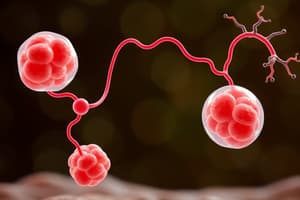Podcast
Questions and Answers
What is the characteristic of the intermediate compounds between glucose and pyruvate?
What is the characteristic of the intermediate compounds between glucose and pyruvate?
- They are dephosphorylated and are neutral.
- They are phosphorylated and carry a positive charge.
- They are phosphorylated and carry a negative charge. (correct)
- They are non-phosphorylated and carry a positive charge.
Why do the intermediate compounds between glucose and pyruvate remain in the cytoplasm?
Why do the intermediate compounds between glucose and pyruvate remain in the cytoplasm?
- Because they are phosphorylated and carry a negative charge. (correct)
- Because they are non-phosphorylated and carry a positive charge.
- Because they are not phosphorylated and are neutral.
- Because they are dephosphorylated and neutral.
What happens to the intermediate compounds between glucose and pyruvate due to phosphorylation?
What happens to the intermediate compounds between glucose and pyruvate due to phosphorylation?
- They gain a positive charge and pass through mitochondrial membranes.
- They gain a negative charge and remain in the cytoplasm. (correct)
- They lose a positive charge and remain in the cytoplasm.
- They lose a negative charge and pass through mitochondrial membranes.
What is the effect of phosphorylation on the intermediate compounds between glucose and pyruvate?
What is the effect of phosphorylation on the intermediate compounds between glucose and pyruvate?
What is the first step in the transformation of glucose?
What is the first step in the transformation of glucose?
Where do the intermediate compounds between glucose and pyruvate remain due to their negative charge?
Where do the intermediate compounds between glucose and pyruvate remain due to their negative charge?
Which enzyme is responsible for the first step in glucose transformation?
Which enzyme is responsible for the first step in glucose transformation?
What is the role of hexokinase in glucose transformation?
What is the role of hexokinase in glucose transformation?
What is the product of the first step in glucose transformation?
What is the product of the first step in glucose transformation?
What is the significance of the first step in glucose transformation?
What is the significance of the first step in glucose transformation?
What is the outcome of the Krebs cycle in the presence of oxygen?
What is the outcome of the Krebs cycle in the presence of oxygen?
What is the role of Mg2+ in the Krebs cycle?
What is the role of Mg2+ in the Krebs cycle?
What is the purpose of TPP (thiamine pyrophosphate) in the Krebs cycle?
What is the purpose of TPP (thiamine pyrophosphate) in the Krebs cycle?
What is the primary function of the Krebs cycle?
What is the primary function of the Krebs cycle?
Where does the Krebs cycle take place in the cell?
Where does the Krebs cycle take place in the cell?
How many molecules of ATP are produced during the phosphate end that terminates with pyruvic acid?
How many molecules of ATP are produced during the phosphate end that terminates with pyruvic acid?
What is the result of glucose being split during the process?
What is the result of glucose being split during the process?
How many times does each step occur for each molecule of glucose?
How many times does each step occur for each molecule of glucose?
What is the endpoint of the phosphate path?
What is the endpoint of the phosphate path?
What happens to the molecule of glucose during the process?
What happens to the molecule of glucose during the process?
What is the characteristic of pyruvate that allows it to pass from the cytosol to the mitochondria?
What is the characteristic of pyruvate that allows it to pass from the cytosol to the mitochondria?
What is the primary purpose of the control points in glycolysis?
What is the primary purpose of the control points in glycolysis?
What is the next step in the process of cellular respiration after pyruvate enters the mitochondria?
What is the next step in the process of cellular respiration after pyruvate enters the mitochondria?
How many control points are present in the glycolytic pathway?
How many control points are present in the glycolytic pathway?
What is the name of the cycle where pyruvate is converted into Acetyl-CoA?
What is the name of the cycle where pyruvate is converted into Acetyl-CoA?
Flashcards are hidden until you start studying
Study Notes
Glycolysis
- Phosphate ends with pyruvic acid, producing 10 ATP
- Glucose is split into two molecules of D-Glyceraldehyde-3-phosphate, with each step occurring twice per molecule of glucose
- All nine intermediate compounds between glucose and pyruvate are phosphorylated, carrying a negative charge, which prevents them from passing through mitochondrial membranes and keeps them in the cytoplasm
Pyruvate
- Pyruvate is not phosphorylated, allowing it to pass from the cytosol to the mitochondria, where it begins aerobic oxidation in the Krebs cycle
Control Points of Glycolysis
- There are three control points in glycolysis, regulated according to the cell's energy requirements
- First control point: transformation of glucose to glucose 6-phosphate, controlled by the hexokinase enzyme
- Second control point: pyruvate enters the mitochondria in the presence of oxygen, starting a chain of reactions to convert to CO2, H2O, and ATP
Krebs Cycle
- In the presence of oxygen, pyruvate enters the mitochondria, beginning a chain of oxidation reactions that end with the conversion of CO2, H2O, and ATP
- The Krebs cycle requires the presence of Mg2+ and thiamine pyrophosphate (TPP) as coenzymes
Studying That Suits You
Use AI to generate personalized quizzes and flashcards to suit your learning preferences.




